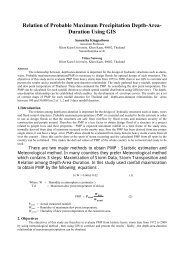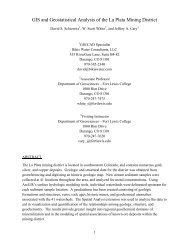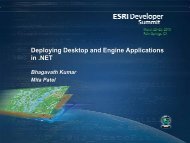A GIS ANALYSIS OF ILLEGAL DUMPING IN THE 78249 ZIP ... - Esri
A GIS ANALYSIS OF ILLEGAL DUMPING IN THE 78249 ZIP ... - Esri
A GIS ANALYSIS OF ILLEGAL DUMPING IN THE 78249 ZIP ... - Esri
You also want an ePaper? Increase the reach of your titles
YUMPU automatically turns print PDFs into web optimized ePapers that Google loves.
A <strong>GIS</strong> <strong>ANALYSIS</strong> <strong>OF</strong> <strong>ILLEGAL</strong> <strong>DUMP<strong>IN</strong>G</strong> <strong>IN</strong> <strong>THE</strong> <strong>78249</strong> <strong>ZIP</strong> CODE <strong>OF</strong> BEXAR COUNTY,<br />
TEXAS<br />
Vincent Romeo, Stephen Brown, and Susan Stuver<br />
ABSTRACT<br />
As the cost of disposing trash, garbage, and construction materials continues to increase, it is likely that<br />
there will also be increasing incidences of illegal dumping across the United States. This presentation will<br />
demonstrate how a <strong>GIS</strong> model was developed by the University of Texas at San Antonio to predict the<br />
susceptibility of urban areas in San Antonio, Texas, to illegal dumping. This presentation will also<br />
demonstrate how the model was developed using the ModelBuilder utility of the ArcView Spatial Analyst<br />
extension and how illegal dump site data collection can be streamlined using GPS.<br />
1. <strong>IN</strong>TRODUCTION<br />
Fly tip, fly dumping, midnight dumping, and illegal dumping are all different names for the same act<br />
(Bellafante, 1991). Illegal garbage dumping can be defined as intentional and illegal abandonment of<br />
household or industrial material on public or private property (Brown, Romeo, and Stuver, 2002). Illegal<br />
dumping is a nuisance because of the physical dangers, aesthetic distaste, and costs associated with it. New<br />
York City, Oakland, Chicago, and Houston all have been noted as cities that have extreme dumping<br />
problems; although, New York’s Sanitation Commissioner, John Doherty, said, “I think almost every city<br />
has the problem to some degree,” (Scherer and Moskowitz, 1995). In New York City they have such a<br />
problem with illegal dumping that inspectors have coined a term “the blanket caper” for an act that<br />
dumpers often use to quickly unload a truck full of debris. A blanket is laid in the back of a pickup truck<br />
and the debris is placed on top. Then once the perpetrators find a location to dump they tie a rope to the<br />
blanket and a fixed object on the ground, like a light pole. Then they drive away leaving the trash, quickly<br />
and effectively making a getaway (Scherer and Freeman, 1995).<br />
Besides being costly and illegal, dumping in this fashion is a human health concern, an aesthetic<br />
problem, and can also be damaging to the environment in a variety of ways. Physical dangers such as
protruding nails can be harmful to animals or children that encounter them, and fires and vermin are also<br />
associated with illegal dumpsites (EPA, 2000). It has been a long battle for local governments to try to<br />
curtail and clean up illegally dumped construction debris, abandoned automobiles, scrap tires, furniture,<br />
and yard and household waste. Contractors, repair shops, and local residents often dump these materials<br />
(Wolkomir, 1994). Bulky waste items such as scrap tires and yard waste are also often dumped because<br />
either they are banned from landfills or proper disposal costs are expensive (U.S. EPA, 1998).<br />
Materials that contain oil, solvent, fuel, or similar liquids can leach through the soil and into<br />
groundwater sources. Many cities have great concern for their already stressed water sources at this time,<br />
and adding pollution to the supply could be extremely harmful to residents that consume this water<br />
(Wolkomir, 1994). Contaminated water that is ingested can manifest itself as kidney and lung damage with<br />
chronic exposure. Cancer can also form in the people drinking the water over a period of time. One<br />
documented example of this type of situation is in Nogales, Sonora, Mexico, where illegal dumping of<br />
Volatile Organic Compounds (VOCs), such as solvents and gasoline, has been linked to contaminated<br />
drinking water (Sanchez, 1995). Chronic exposure to low concentrations of VOCs can be long lasting, with<br />
potential irreversible effects. Some VOCs, such as Benzene (a primary ingredient in gasoline), is stable<br />
and can accumulate in the body over a period of time, which can then contribute to kidney and liver<br />
damage, cancer, reproductive problems, and general nervous system problems (Total Environmental<br />
Center, 2001).<br />
Asbestos containing material is often found illegally dumped as ceiling tiles, roof shingles, floor<br />
tiles, and cement. According to the Texas Department of Health these materials can cause asbestosis,<br />
which is a form of fibrotic lung disease that causes difficult breathing, coughing, and chest pain (Texas<br />
Department of Health, 2001).<br />
Dumping in unauthorized areas is illegal and federally enforceable under the Protection of the<br />
Environment Operation Act of 1997 (U.S EPA, 2000), which allows the government to fine companies and<br />
individuals for a variety of harmful environmental operations and negligence. Protection of the<br />
Environment Operation Act (PEO) fines range from $600 to 1 million dollars per day. Local laws are also<br />
often used to prosecute these types of crimes.
In Texas, the Texas Commission on Environmental Quality (TCEQ) is the regulating body for<br />
environmental permitting, inspections, and control. The TCEQ has one central office in Austin and sixteen<br />
regional offices that provide inspectors for the local areas that they support. Often state regulatory offices<br />
are understaffed and overloaded with work, but they do the best they can to catch offenders for a myriad of<br />
violations, including illegal dumping (Wolkomir, 1994). The difficult part is that they usually have to catch<br />
the illegal dumping in progress for a conviction, which is very difficult considering that it only takes a few<br />
minutes for someone to unload a truckload of waste.<br />
The Texas legislature has promulgated a wide range of rules to punish illegal dumping offenders.<br />
Texas Administrative Codes that can deal with illegal dumpers are:<br />
• Texas Health and Safety Code Chapter 343 - Abatement of Public Nuisances: This tort<br />
law is specifically for use in unincorporated portions of a county. It can be used to<br />
prosecute a wide variety of dumping situations. This law can be used against dumping on<br />
personal land if it is visible.<br />
• Texas Health and Safety Code Chapter 361 – Solid Waste Disposal Act: Commonly<br />
known as the SWDA, this Act is primarily used to prosecute known waste handlers.<br />
Known handlers of solid waste that contribute to illegal dumping can be punished using<br />
the SWDA. This Act does not enforce hazardous waste.<br />
• Texas Water Code Chapter 7: Focused on protection of lakes, rivers, and, water sources,<br />
the TWC can be used to punish people or companies that impact water with their illegal<br />
dumping activities.<br />
• Ordinary Misdemeanor Punishments - Penal Code: The general purpose of this code is to<br />
establish a system to deal with conduct that causes or threatens to harm others, where<br />
state protection is needed. The Penal Code covers many different enforcement areas that<br />
include illegal dumping.<br />
Local governments often manage dumping by cleaning it up as quickly as possible. A typical<br />
response to a citizen reporting illegal dumping is for a city to dispatch a cleanup crew. Crews can consist<br />
of a dump truck followed by a truck-mounted crane to load the waste into the dump truck. City codes often<br />
restrict dumping anywhere but in permitted local landfills, such as city codes 6027A and B and 6085A and<br />
B in San Antonio Texas. These codes outline the offense definition and how much the fine should be; a<br />
violation of one of these codes for dumping/littering can cost as much as $2000. In San Antonio, calling<br />
311 from your household phone will contact the city for reporting illegal dumping activity (The City of San<br />
Antonio, 2002).
The City of San Antonio spends several hundred million dollars each year dealing with illegal<br />
dumping issues according to Mrs. Liza Meyers (2002), the Clean Community Coordinator of the Solid<br />
Waste Division for the Department of Environmental Services. She attributes these costs in part to the lack<br />
of San Antonio having its own permitted landfill. San Antonio relies on corporate owned landfill services<br />
for their refuse disposal.<br />
The ideal setting to use as a sample area for studying illegal dumping should have a cross-section<br />
of the human population. A location that represents a variety of people in density, distribution, and vital<br />
statistics is needed to build maximum flexibility into the model during the building process. A zip code<br />
provides a workable size to begin developing a model, and it is big enough to encompass a large amount of<br />
people, but not so many as to overwhelm the development process. Once the model is developed and<br />
applied it can then be adapted to a broader scale.<br />
The <strong>78249</strong> zip code of San Antonio provided an appropriate study area. It met the criteria set<br />
forth and was also the same zip code that UTSA is located in and there was an abundance of dumpsites<br />
within it. This zip code has diversity in income level as well as property upkeep. Physical property<br />
characteristics of this zip code vary from well maintained to dilapidated, based on visual inspection.<br />
Curbside trash pick up is the norm although there are areas, such as a mobile home park, that do not receive<br />
curbside trash pickup. Some apartment residents and businesses use private disposal services and there was<br />
construction occurring in several areas within the zip code during this study.<br />
The objective of this thesis was to study spatial characteristics of illegal dumping and create an<br />
index model to predict illegal-dumping locations based on sample data characteristics. The <strong>78249</strong> zip code<br />
in San Antonio, TX has illegal dumping in certain areas, but it also has areas that are clean with no<br />
dumping. Data collected from the proposed study area was used to provide insight on how to build the<br />
model. Visiting illegal dumpsites and collecting information about each one helped to assess important<br />
information needs for development of a predictive model.
2. DATA COLLECTION METHODS<br />
To begin scouting the zip code an observation set was developed (Allen, O’Neal, and Hoekstra,<br />
1984). First, illegal dumpsites were identified as the objects of study. At the start, aerial photography was<br />
used to scrutinize the ground in certain areas looking for indications of characteristics that could warrant<br />
ground truthing. This use of aerial photography established a different level of perception for locating<br />
dumpsites unlike being on the ground. This in turn determined the structural entities that were<br />
discriminated in the photos to focus on small points among the forest matrix of the zip code.<br />
After the first objective was addressed the phenomena of interest were identified as part two of the<br />
observation set. Two specific phenomena were determined for the aerial photography to identify:<br />
1. Visible illegal dumping, open spaces that were not near road access were scanned for<br />
evidence of illegal dumping.<br />
2. Vacant lots and road dead ends within sub divisions/housing areas, were checked for<br />
illegal dumping
GPS data collection began May 1, 2002 and continued through July 31, 2002 within the <strong>78249</strong> zip<br />
code. GPS based units were used to map and collect information about dumpsites in the sample zip code to<br />
help correlate relationships between the surrounding environment and illegal dumping locations. The data<br />
dictionary desktop software that interacts with the mobile GPS unit is shown as Figure 2-1 (Trimble, 1999).<br />
Trimble's BoB receiver is a compact real-time differential correction receiver that was used to correct data<br />
in real-time as points were collected. Trimble Pathfinder software was used to download local Department<br />
of Transportation base station points through the world-wide-web. Pathfinder was then used to<br />
differentially correct the data points that were not real time corrected using the BoB.<br />
The data dictionary used for this work was created based on previous research similar to this study<br />
(Brown, Romeo, and Stuver, 2002). It was adjusted from the previous version specifically for collecting<br />
information on grouped or sporadic dumping in the <strong>78249</strong> zip code. The data dictionary for the dump site<br />
survey was adjusted to provide as much insight as possible into characteristics pertaining to illegal dumping<br />
and how to predict its occurrence.<br />
Abstract terms were used to describe two key characteristics recorded in the data dictionary,<br />
visibility and accessibility. Ratings were assigned based on a scale of 1, 2, and 3. The 1 was given the<br />
lowest rank, with 2 being the middle ground, and 3 being the highest ranking. Each pile was given a<br />
ranking of a 1, 2, or 3 for access and visibility. Sites that were next to paved roadways were considered to<br />
be highly accessible and received a ranking of a 3 in the data dictionary. If a site was not difficult to get to,<br />
but was not adjacent to a paved roadway a 2 was assigned. A 1 was given to sites with low access that<br />
were difficult to get to, and visibility was ranked similarly. Dumpsites that were highly visible from<br />
roadways received a ranking of a 3, whereas piles more difficult to see were assigned a 2. Still more<br />
difficult to see or not visible sites were assigned a 1 in visibility. To sum it up, access and visibility were<br />
rated separately on a scale of 1 to 3, with a 3 meaning that the dump site was either easily accessible or<br />
highly visible. A rating of 1 indicated that the area was either not easy to access or see.<br />
The collected data provided information so that statistical values were calculated on access,<br />
visibility, area, and composition of the debris in each dump site. Illegally dumped materials that were<br />
mapped were grouped into the categories of the data dictionary: brush, municipal solid waste, industrial<br />
solid waste, asbestos containing material, and tires. The collected accessibility and visibility characteristics
were assigned values in a weighted overlay process according to their effect on site probability for use as<br />
an illegal dump site. The numerical indexing of these traits was developed in a Geographic Information<br />
System (<strong>GIS</strong>) interface that effectively created a model to predict areas that have a high probability of<br />
being used for illegal dumping.<br />
3. RESULTS<br />
Analysis showed 15% or 27 out of 170 of the dumpsites being both highly visible (rating of 3) and<br />
highly accessible. Forty-one dumpsites were difficult to access and were not visible, which amounted to<br />
23% of the total data. Two extreme categories were possible within the collected dump site data, highest<br />
visibility and lowest access, and highest access with the lowest visibility. Neither of these categories<br />
occurred in the data. Table 3-1 presents each data combination between Visibility (Vx) and Accessibility<br />
(Ax).<br />
Statistical analysis was applied to the GPS data to reveal any positive or negative correlations<br />
between three key data characteristics that were collected for each dump site, Visibility, Accessibility, and<br />
Volume. This evaluation aided in selecting the appropriate variables from the data dictionary that<br />
eventually led to proper weighting within the model. A Spearman’s Correlation matrix was put together to<br />
evaluate the strength of relationships between these variables. Spearman's Correlation Coefficient is a non-<br />
parametric analysis. It expresses the strength of the relationship on a scale ranging from –1 to 1.<br />
Spearman's Correlation Coefficient is usually signified by r (rho), and can take on the values from -1.0 to<br />
1.0 (Sparks, 2000). Where -1.0 is a perfect negative (inverse) correlation, 0.0 is no correlation, and 1.0 is a<br />
perfect positive correlation.<br />
Table 3-1<br />
DATA CHARACTER # %<br />
V1 A1 41 23<br />
V1 A2 33 18<br />
V1 A3 0 0<br />
V2 A1 7 4
V2A2 54 31<br />
V2A3 9 5<br />
V3 A1 0 0<br />
V3 A 2 7 4<br />
V3 A3 27 15<br />
Collected data for Visibility (V) and Accessibility (A)<br />
and the 9 possible combinations of rating values.<br />
Spearman’s does not use the actual observed data, but the ranks of the data to calculate a correlation<br />
coefficient. Spearman’s was applied to the data to evaluate any possible non-linear correlations (Table 3-<br />
2). The 0.829 value represents a strong correlation between<br />
access and visibility. Spearman’s indicated a strong relationship and has also shown a significant negative<br />
correlation for volume and access.<br />
Processing on the collected data revealed several key characteristics. Street accessibility and<br />
vacant areas played a role in the location and density of illegal dumping in the test area. These<br />
observations were represented by the visibility and accessibility values that were recorded for each dump<br />
location during data collection. For this model to possibly be used in an area other than the <strong>78249</strong> zip code,<br />
the data that the model uses to provide an output must be available for many areas. Ideally a model should<br />
be applicable to different variables for the particular scenario that it is used for. It must also be available<br />
in a common format that the software model can use. It is also necessary for the data source to be reliable<br />
and accurate for the model output to provide useful information. Data that was used to construct the model<br />
fit three characteristics:<br />
Table 3-2<br />
Spearman Rank Correlations<br />
Visibility Access Volume<br />
Visibility 1.000 0.829 -0.107<br />
Access 1.000 -0.177<br />
Volume 1.000<br />
1. Common availability of data,<br />
2. Best available level of accuracy,
3. Attainable for many locations.<br />
The 911 streets data is commonly available nationwide in metropolitan areas where illegal<br />
dumping commonly occurs. The parcel data was obtained from the local county tax appraisal office.<br />
Texas is structured in this way, so data of this type is readily available within the State. The Bexar County<br />
Appraisal District office has collected and built this data up over the last 25 years using their manpower,<br />
and considering that taxes are justified from these maps expresses their need for correctness.<br />
4. DISCUSSION<br />
A model was built using ModelBuilder based on the collected data. Running the model suggested<br />
illegal dumping was much more likely to occur near easily accessible roads. This model has five<br />
“function” modules.<br />
Intuitively it seems that sites just out of the way of the main thoroughfares would be targeted, but<br />
the model did not distinguish this. Some dumpsites were along major traffic streets, however the model did<br />
not differentiate street usage.<br />
Figure 4-6 exhibits a comparison of the model and the collected data of where actual illegal<br />
dumpsites were located in the zip code between May and July 2002. Several attempts were made to use<br />
Arcview tools to provide analysis of the accuracy of the model projection. Theme by theme selection was<br />
first attempted, but it did not work because this function cannot accommodate analysis between the street<br />
and parcel output grids and the vector dump site points. The vector points of the dumpsites were<br />
transferred to a grid file, but needed information was not provided. An extension called point in polygon<br />
was also applied and the same problems were encountered. The failure of these attempted analysis exhibits<br />
a diversion and limitation in Arcview between analysis of grid files and shape files.<br />
The layout was printed out and each point was classified as to whether it fell in the predicted areas.<br />
Analysis indicated 52 dumpsites fell in the red zone of the model that indicates finding dumpsites in this<br />
area is highly likely. There were 45 sites within the orange zone that indicates dumpsites are likely to be<br />
found in this area, and 39 sites were found in the yellow area of the predictive model indicating dumpsites
are likely to be found in this area, but lesser so than the red or orange zones. Sites were also found to be<br />
present in areas that were not predicted by the predictive model, although only 34 were found. There were<br />
136 dumpsites (80 percent) found within the model’s predictive areas, whereas only 34 were found outside<br />
the areas.<br />
5. CONCLUSION<br />
TABLE 4-1<br />
MODEL ACCURACY # %<br />
Red Zone Dump Site Hits 52 31<br />
Orange Zone Dump Site Hits 45 26<br />
Yellow Zone Dump Site Hits 39 23<br />
Outside Predictive Areas 34 20<br />
Adding subcategories or expanding the categories from Visibility, Accessibility, and Volume may<br />
aid in identifying key features that impact illegal dumping location choice. Classifying streets by traffic<br />
volume may refine the model, by providing that less traveled roads could be a predictor for dumping just<br />
out of sight. It is also not known if proximity to city landfills is a factor on whether someone will dump<br />
illegally. Adapting this model to a city or region is also a development theme, but this application would<br />
require processing of a large amount of data. At its current state the predictive model indicates that the<br />
most likely dumping areas are within the close proximity of the road. This indication means that a model is<br />
not necessary for prediction of illegal dumping activities unless amended to provide more information.<br />
Dumpsites were found in the sample zip code areas because they were near congested living areas without<br />
adequate venues for proper disposal. It seems that the knowledge of proper disposal among the public may<br />
need to be increased. Increasing drop off areas for waste could also have a positive impact in reduction of<br />
illegal dumping. Demographics were not thoroughly investigated in this study, so there is not an<br />
establishment of whether characteristics of human population in the area directly contribute to the dumping
problem in the <strong>78249</strong> zip code or if others bring it into this area because of the historic presence of<br />
dumpsites.<br />
Houston Texas has also attacked the problem using a similar type of strategy. The city set up a<br />
program called “Rat on a Rat” that has a special phone line for illegal dumping reporting, and since its<br />
inception two years ago; $5,200 dollars have been handed out as reward money for people that have turned<br />
in illegal dumpers. Houston has nine personnel that work this issue, and if they catch you dumping<br />
illegally you will get to clean up the mess. Last year prosecuted dumpers cleaned up 3,000 tons of trash<br />
and debris! Houston has also found that 50 percent of illegal dumpers have criminal records. Tim Collins,<br />
the city’s assistant chief inspector, noted that, “People have figured out its one more easy scam,” (Scherer<br />
and Moskowitz, 1995). Under Houston city code, the maximum penalty for dumping more than five<br />
pounds of trash in Houston is a year in jail and a $4,000 dollar fine, as well as being legally forced to clean<br />
up their discarded materials.<br />
The City of San Antonio’s Clean Community Coordinator, Liza Meyers (2002), is spearheading a<br />
pilot program based on Houston’s success. The program is starting off by offering illegal dumping<br />
reporters a $50.00 cash reward if their tip leads to prosecution. The program kicked off in March of 2002<br />
and has solid legal enforcement through the Texas Health and Safety Code, Texas Solid Waste Code, and<br />
the Texas Water Code.<br />
References<br />
Allen, T. F. H., O’Neall, R. V., and Hoekstra, T. W. 1984. Interlevel Relations in<br />
Ecological Research and Management: Some Working Principles from Hierarchy<br />
Theory, USDA Forest Service Technical Report RM-110.<br />
Bellafante, G. 1991. Garbage Dictionary, Garbage, Vol. 3(1), pp. 18.<br />
Berk, K. and Carey, P. 2000. Data Analysis With Microsoft Excel. Duxbury Press,<br />
Pacific Grove, California.
Brown, S. C., Romeo, V., and Stuver, S. K. 2002. A <strong>GIS</strong> Model for Predicting<br />
Occurrences of Illegal Dumping, 22 nd Annual ESRI International Users Conference, San Diego,<br />
California.<br />
Environmental Research Systems Institute, Inc. 1999. ESRI Data and Maps.<br />
Environmental Systems Research Institute, Inc., Redlands, California.<br />
Menking, K. 2002a. Appraisal District <strong>GIS</strong> file. San Antonio: Bexar County Appraisal<br />
District archive.<br />
Menking, K. 2002b. Personal interview with Bexar County Appraisal District’s Geographic Information<br />
Systems coordinator.<br />
Meyers, L. 2002. Interview by phone with The City of San Antonio’s Clean<br />
Community Coordinator.<br />
Ormsby, T. and Alvi, J. 1999. Extending Arcview <strong>GIS</strong>. ESRI Press, Redlands,<br />
California.<br />
Ryan, D. 2002. 911 Streets <strong>GIS</strong> File for <strong>78249</strong> Zip Code. San Antonio: Alamo Area<br />
Council of Governments.<br />
Sanchez, R. A., 1995. Water Quality Problems in Nogales, Sonora, Environmental<br />
Health Perspectives Supplements, Vol. 103(1), p. 93.<br />
Scherer, R. and Moskowitz, E. 1995. “Illegal Dumping: Not Only in New York”,<br />
Christian Science Monitor, Vol. 87(176) p. 10.<br />
Scherer, R. and Freeman M. 1995. “On the Prowl With the Sanitation Police”,<br />
Christian Science Monitor, Vol. 87(176) p. 10.<br />
Sparks, T. 2000. Statistics in Ecotoxicology. John Wiley and Sons, West Sussex,<br />
England.<br />
TCEQ - Texas Commission on Environmental Quality, 2002.<br />
http://www.tnrcc.state.tx.us/exec/sbea/locgov/msw.html#battle
The City of San Antonio, 2002. Illegal Dumping in Bexar County. San Antonio,<br />
Texas.<br />
The City of San Antonio Household Hazardous Waste Collection Center. 2002.<br />
http://www.ci.sat.tx.us/enviro/emd/HHW_DOC.htm.<br />
Texas Department of Health 2001. Environmental Epidemiology and Toxicology<br />
Division, http://www.tdh.state.tx.us/epitox/asbestosis.htm.<br />
Total Environmental Center, 2001. Solvents: Health Effects. Total Environmental<br />
Center. Sydney, Australia.<br />
Trimble Navigation Limited. 1999. Pathfinder Office. Trimble Navigation Limited,<br />
Sunnyvale, California.<br />
U.S. Environmental Protection Agency. 2000a. #2 Waste Dumping Fact Sheet.<br />
U.S. Environmental Protection Agency. 1998b. Illegal Dumping Prevention<br />
Guidebook.<br />
Wolkomir, R. 1994. “Hot on The Trail of Toxic Dumpers and Other Eco-Outlaws<br />
Texas Style”, Smithsonian, Vol. 25(2), p. 26.<br />
Author's Contact Information:<br />
Stephen C. Brown<br />
Vincent A. Romeo<br />
Department of Earth and Environmental Sciences<br />
University of Texas at San Antonio<br />
6900 N. Loop 1604 W.<br />
San Antonio, Texas, <strong>78249</strong> USA<br />
(210) 458-4956 (voice)<br />
sbrown@utsa.edu (email)<br />
Susan K. Stuver<br />
Environmental Services Division<br />
City of San Antonio<br />
P.O. Box 839966<br />
San Antonio, Texas 78283 USA<br />
(210) 207-6449 (voice)<br />
sstuver@ci.sat.tx.us
















